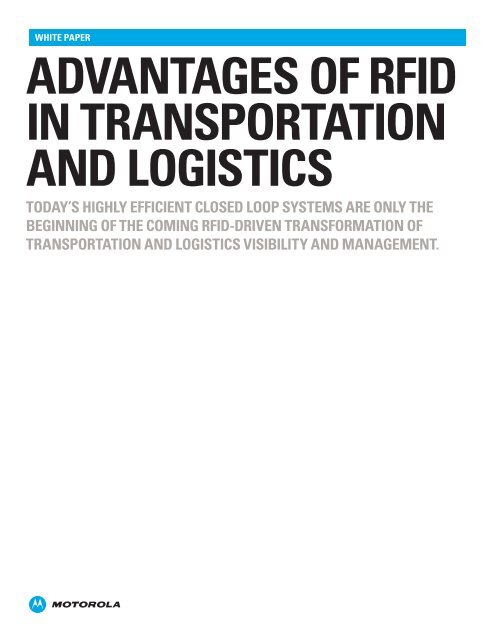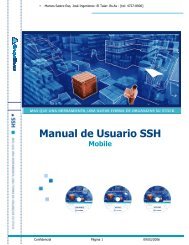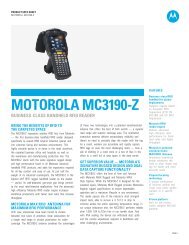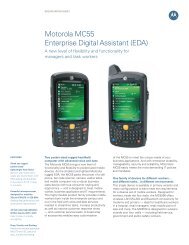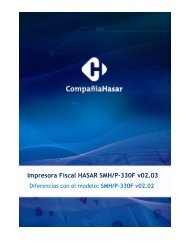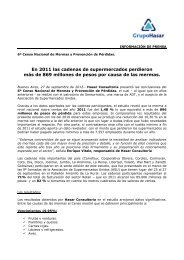Advantages of RFID in Transportation & Logistics - Motorola Solutions
Advantages of RFID in Transportation & Logistics - Motorola Solutions
Advantages of RFID in Transportation & Logistics - Motorola Solutions
Create successful ePaper yourself
Turn your PDF publications into a flip-book with our unique Google optimized e-Paper software.
WHITE PAPERADVANTAGES OF <strong>RFID</strong>IN TRANSPORTATIONAND LOGISTICSTODAY’S HIGHLY EFFICIENT CLOSED LOOP SYSTEMS ARE ONLY THEBEGINNING OF THE COMING <strong>RFID</strong>-DRIVEN TRANSFORMATION OFTRANSPORTATION AND LOGISTICS VISIBILITY AND MANAGEMENT.
WHITE PAPER<strong>RFID</strong>: DRIVING THE VISIBLE SUPPLY CHAINTHE NEED FOR VISIBILITYOptimized supply cha<strong>in</strong> management is based on gett<strong>in</strong>gmore done <strong>in</strong> less time and with fewer resources. Many <strong>of</strong>today’s transportation and logistics bus<strong>in</strong>esses struggle totame both their asset management and supply cha<strong>in</strong>operations. Virtually every bus<strong>in</strong>ess or <strong>in</strong>stitution with anextensive supply cha<strong>in</strong> f<strong>in</strong>ds that optimiz<strong>in</strong>g it is a processf<strong>in</strong>ds that supply cha<strong>in</strong> optimization is a process that’stime-<strong>in</strong>tensive, largely based on manual procedures, proneto human error and <strong>in</strong>creas<strong>in</strong>gly costly. In focus<strong>in</strong>g on theseissues, bus<strong>in</strong>esses are work<strong>in</strong>g to <strong>in</strong>crease asset, <strong>in</strong>ventoryand shipment visibility <strong>in</strong> every l<strong>in</strong>k <strong>of</strong> the cha<strong>in</strong>. That’s notsurpris<strong>in</strong>g. It’s hard to track and manage what you can’tsee. End-to-end visibility facilitates more effective, timelierdecisions; reduces delays through prompt detection,report<strong>in</strong>g and resolution <strong>of</strong> operational anomalies; allowsswift rerout<strong>in</strong>g <strong>of</strong> goods <strong>in</strong> transit to meet chang<strong>in</strong>gbus<strong>in</strong>ess requirements; and provides real-time track<strong>in</strong>gstatus and traceability.AN <strong>RFID</strong> REFRESHERFor many organizations, the solution is the automation <strong>of</strong>visibility and management processes. Most transportationand logistics companies have been us<strong>in</strong>g barcod<strong>in</strong>gsuccessfully for years now. A grow<strong>in</strong>g number are alsoadd<strong>in</strong>g Radio Frequency Identification (<strong>RFID</strong>) solutions. <strong>RFID</strong>is essentially a more automated way <strong>of</strong> know<strong>in</strong>g what youhave and where it is. There are substantial differencesbetween barcod<strong>in</strong>g and <strong>RFID</strong>. One <strong>of</strong> the most significant isthe fact that barcodes need a clear l<strong>in</strong>e-<strong>of</strong>-sight to bar codescanners, mak<strong>in</strong>g them difficult and slow to work with <strong>in</strong>many locations and situations. Another is the high number<strong>of</strong> manhours it takes to count shipments, <strong>in</strong>ventory andassets with barcodes. In addition, barcodes are able toidentify only the type or class <strong>of</strong> goods, rather than<strong>in</strong>dividual items.<strong>RFID</strong>, on the other hand, identifies and locates every s<strong>in</strong>gleitem you want to track, from trucks to forklifts to returnabletransit items (RTIs) to conta<strong>in</strong>ers to whatever is be<strong>in</strong>gshipped <strong>in</strong> them. With <strong>RFID</strong> there are no l<strong>in</strong>e-<strong>of</strong>-sightrequirements, so you can read a great many tagssimultaneously. <strong>RFID</strong> lets you read, write and re-write t<strong>of</strong>lexible, low-cost tags that <strong>of</strong>fer greater data capacity,durability <strong>in</strong> harsh environments and the security <strong>of</strong> be<strong>in</strong>gdifficult to replicate. And you can read them at distances <strong>of</strong>up to 30 feet.An <strong>RFID</strong> system <strong>in</strong>cludes tags, or transponders, that <strong>in</strong>cludea small antenna and a chip that can hold a significantamount <strong>of</strong> data such as product number, manufacturer,location and much more. It also <strong>in</strong>cludes three basic types<strong>of</strong> <strong>RFID</strong> readers.• Fixed readers have an external antenna and are <strong>of</strong>tenlocated at entry po<strong>in</strong>ts to facilities and yards.• Handheld readers provide on-demand scann<strong>in</strong>g and areused by personnel mov<strong>in</strong>g through the space.• Mobile readers can be located on mov<strong>in</strong>g equipment,such as trucks and forklifts, for faster, more accurate<strong>in</strong>ventory and process track<strong>in</strong>g.“WITH A BARCODE SCAN, YOU HAVE A ONE-TO-ONERELATIONSHIP, BUT WITH <strong>RFID</strong> YOU CAN HAVE AONE-TO-MANY RELATIONSHIP, AND THAT’S WHERE YOUSEE A SIGNIFICANT INCREASE IN EFFICIENCIES. INSTEADOF HAVING TO TOUCH EACH ITEM ONE AT A TIME, <strong>RFID</strong>BASICALLY THROWS AN UMBRELLA OF ENERGY AROUNDAN AREA OR A BOX AND DETECTS EVERYTHING IN IT.”– L. ALLEN BENNETT, CEO AND PRESIDENTENTIGRAL SYSTEMS, GREENSBORO, NORTH CAROLINAPAGE 3
WHITE PAPER<strong>RFID</strong>: DRIVING THE VISIBLE SUPPLY CHAINReaders work by send<strong>in</strong>g an RF signal at a selectedfrequency, energiz<strong>in</strong>g tags to send their stored <strong>in</strong>formationto the reader and system server. Depend<strong>in</strong>g on your project,you can choose from UHF “passive” tags that use the <strong>RFID</strong>reader for power, or “active” tags that cost more but havetheir own batteries and can be used for projects that requirelonger read ranges. UHF passive tags are <strong>in</strong>creas<strong>in</strong>gly be<strong>in</strong>gdeployed because the lower tag costs allow <strong>in</strong>creasedvisibility <strong>in</strong>to broader categories <strong>of</strong> goods and assets. Nomatter which tags are right for your solution, the benefits <strong>of</strong><strong>RFID</strong> can be significant. In general, the <strong>in</strong>dustry is see<strong>in</strong>gabout a 10 percent improvement <strong>in</strong> count<strong>in</strong>g efficiencywith <strong>RFID</strong>.<strong>RFID</strong> VISIBILITY BENEFITSEssentially, <strong>RFID</strong> gives transportation and logisticsoperations <strong>in</strong>creased visibility <strong>in</strong>to equipment, <strong>in</strong>ventory andbus<strong>in</strong>ess processes. It <strong>in</strong>creases your efficiency byshorten<strong>in</strong>g processes and and streaml<strong>in</strong><strong>in</strong>g your datacapture procedures, and <strong>in</strong>creases accuracy by m<strong>in</strong>imiz<strong>in</strong>gor elim<strong>in</strong>at<strong>in</strong>g error-prone, time-wast<strong>in</strong>g manual processes.It reduces labor costs with automated processes that utilizealways-on fixed <strong>RFID</strong> readers and it <strong>in</strong>creases productivitywith mobile and on-demand handheld readers. <strong>RFID</strong>provides real-time data that gives you up-to-date<strong>in</strong>formation across your entire supply cha<strong>in</strong>. <strong>RFID</strong> solutionswill help you lower your operat<strong>in</strong>g costs, <strong>in</strong>creasethroughput <strong>in</strong> your distribution centers, maximize on-timedeliveries and improve customer service and satisfaction.In addition, for most transportation and logistics bus<strong>in</strong>esses,the visibility provided by <strong>RFID</strong> provides benefits well beyondthe supply cha<strong>in</strong>. Forward-look<strong>in</strong>g companies are us<strong>in</strong>g <strong>RFID</strong>technology to <strong>in</strong>crease efficiency <strong>in</strong> numerous otherapplications such as receiv<strong>in</strong>g and put away, deliveryconfirmation, returns process<strong>in</strong>g, <strong>in</strong>ventory and security.<strong>RFID</strong> HARD AT WORKEven as <strong>RFID</strong> is poised to transform transparency andefficiency throughout the entire global supply cha<strong>in</strong>, it isalready a hard work<strong>in</strong>g transportation and logistics solution.Over the last few years, <strong>RFID</strong> systems have been help<strong>in</strong>g agrow<strong>in</strong>g number <strong>of</strong> operations optimize both asset and<strong>in</strong>ventory management, us<strong>in</strong>g both <strong>in</strong>ternal, or closed loopimplementations, and external, or open loop systems. Intoday’s logistics <strong>in</strong>dustry, companies are us<strong>in</strong>g <strong>RFID</strong> forshipment and asset track<strong>in</strong>g and management, warehouseand distribution management and yard management.Track<strong>in</strong>g ManagementOne <strong>of</strong> the biggest bus<strong>in</strong>ess issues <strong>in</strong> our <strong>in</strong>dustry is lack <strong>of</strong>visibility <strong>of</strong> shipments and goods and the implications thatthis lack <strong>of</strong> visibility can have on <strong>in</strong> customer service. Whenyou don’t know where a trailer, conta<strong>in</strong>er, or pallet is at anygiven time, you don’t know where your products are, andneither do your customers. Efficiency suffers, assetutilization shr<strong>in</strong>ks, labor costs <strong>in</strong>crease, asset productivityand value lessen and payments are delayed. <strong>RFID</strong> solutionsare currently solv<strong>in</strong>g these <strong>in</strong>ternal asset management andtrack<strong>in</strong>g problems for a grow<strong>in</strong>g number <strong>of</strong> logisticscompanies and departments all over the world.One <strong>of</strong> Asia’s largest logistics organizations, Toll Global<strong>Logistics</strong> needed to more efficiently track goods andshipments at its S<strong>in</strong>gapore facility. With goals <strong>in</strong>clud<strong>in</strong>greduc<strong>in</strong>g manhours by decreas<strong>in</strong>g reliance on manualprocedures and <strong>in</strong>creas<strong>in</strong>g visibility for the company and itscustomers, the organization deployed a system that tagged“INCREASED SUPPLY CHAIN VISIBILITY BASED ON<strong>RFID</strong> READS COULD GIVE COMPANIES A BETTER VIEWOF WHEN INVENTORY PROBLEMS MIGHT BE ARISING,ALLOWING THEM TO TAKE EARLIER ACTION THATMIGHT RELIEVE THE NEED FOR (AND COST OF)EXPEDITING FREIGHT.”– SUPPLY CHAIN DIGEST ARTICLE, APRIL 2009PAGE 4
WHITE PAPER<strong>RFID</strong>: DRIVING THE VISIBLE SUPPLY CHAINeach <strong>of</strong> the location’s 150,000 pallets with UHF passive <strong>RFID</strong>tags. When shipments arrive, staff members scan thebarcodes on the boxes, then use a portal to read <strong>RFID</strong> tagson the pallets these boxes are loaded <strong>in</strong>to (or taken out <strong>of</strong>).The pallet identification data are then l<strong>in</strong>ked and sent viaWiFi to s<strong>of</strong>tware that stores the data and makes it availableto both <strong>in</strong>ternal users and customers. Toll Global <strong>Logistics</strong>estimates that the system will save about six m<strong>in</strong>utes <strong>of</strong>staff time per pallet, result<strong>in</strong>g <strong>in</strong> more than 600 man-daysper year.Warehouse ManagementIn warehouses and distribution centers, <strong>RFID</strong> solutions arehelp<strong>in</strong>g to deliver process improvements that positivelyimpact customer satisfaction and your bottom l<strong>in</strong>e. <strong>RFID</strong>automation helps <strong>in</strong>crease efficiency <strong>in</strong> receiv<strong>in</strong>g, sortation,rout<strong>in</strong>g, location<strong>in</strong>g and shipp<strong>in</strong>g, Use <strong>of</strong> <strong>RFID</strong>-enabledequipment, such as forklifts and handheld <strong>RFID</strong> readers,automates <strong>in</strong>formation capture, allow<strong>in</strong>g thousands <strong>of</strong>items to be scanned simultaneously and elim<strong>in</strong>at<strong>in</strong>g costly,error-prone pen and pencil record<strong>in</strong>g or time-consum<strong>in</strong>ghandheld barcode scann<strong>in</strong>g. <strong>RFID</strong> automation <strong>in</strong>creasespick<strong>in</strong>g and putaway efficiency, maximizes order accuracyand m<strong>in</strong>imizes re-deliveries. Your labor productivity isenhanced throughout the facility. Most important, with <strong>RFID</strong>streaml<strong>in</strong><strong>in</strong>g end-to-end workflow, you assure that the rightgoods reach the right customer at the right time.Southeastern Conta<strong>in</strong>er manufactures plastic bottlepre-forms <strong>in</strong> three <strong>in</strong>jection-mold<strong>in</strong>g facilities <strong>in</strong> the easternUnited States. Pre-forms are then shipped to bottlemanufactur<strong>in</strong>g plants <strong>in</strong> cardboard conta<strong>in</strong>ers and plasticb<strong>in</strong>s, with empty conta<strong>in</strong>ers be<strong>in</strong>g returned to the mold<strong>in</strong>gfacility to repeat the cycle. But problems <strong>in</strong> the returnprocess were cost<strong>in</strong>g thousands <strong>of</strong> dollars a year due to lossand damage. The company replaced exist<strong>in</strong>g conta<strong>in</strong>erswith RTIs, returnable fold<strong>in</strong>g plastic b<strong>in</strong>s designed to<strong>in</strong>crease efficiency and reduce cost. S<strong>in</strong>ce these newconta<strong>in</strong>ers cost nearly ten times the cost <strong>of</strong> a cardboardconta<strong>in</strong>er, Southeast Conta<strong>in</strong>er <strong>in</strong>troduced an <strong>RFID</strong>-drivenend-to-end cycle count<strong>in</strong>g system to track conta<strong>in</strong>erlifetimes aga<strong>in</strong>st the number <strong>of</strong> cycles guaranteed by themanufacturer. Each conta<strong>in</strong>er is permanently identified witha passive <strong>RFID</strong> tag for locat<strong>in</strong>g and track<strong>in</strong>g each unit <strong>in</strong> realtime, enhanc<strong>in</strong>g visibility and extract<strong>in</strong>g maximum bus<strong>in</strong>essvalue from each conta<strong>in</strong>er. The company expects to achievepayback on this project <strong>in</strong> less than two years.Yard ManagementIn many transportation and logistics organizations, yardmanagement is the last bastion <strong>of</strong> manual processes. Theprocess is virtually the same—and just as <strong>in</strong>efficient— theworld over. You have an employee mov<strong>in</strong>g through the yardon foot or <strong>in</strong> a vehicle, count<strong>in</strong>g how many pieces <strong>of</strong>equipment, conta<strong>in</strong>ers and vehicles are <strong>in</strong> the yard andnot<strong>in</strong>g their location on paper with pen or pencil. It’s atime-<strong>in</strong>tensive and error-prone process that causes anumber <strong>of</strong> visibility-related problems, <strong>in</strong>clud<strong>in</strong>g redundanttrailer moves, shipp<strong>in</strong>g delays and costly penalties, yard andgate congestion, product shr<strong>in</strong>kage, excessive use <strong>of</strong>refrigeration, wasted fuel and lost time. To address theseproblems, numerous organizations across the supply cha<strong>in</strong>are turn<strong>in</strong>g to <strong>RFID</strong> systems that automate asset track<strong>in</strong>gand location<strong>in</strong>g and reduce or elim<strong>in</strong>ate manual processes<strong>in</strong> these yard-based environments. <strong>RFID</strong> is able tosignificantly reduce human <strong>in</strong>tervention by, enabl<strong>in</strong>gmach<strong>in</strong>e-to-mach<strong>in</strong>e <strong>in</strong>formation shar<strong>in</strong>g to greatly enhanceaccuracy.In a large Kimberley-Clark production facility, eight differentdepartments are request<strong>in</strong>g trailer moves every day. Try<strong>in</strong>gto manage the yard, the company performs daily four-hourmanual yard checks. Even so, significant time and dollarsare be<strong>in</strong>g wasted try<strong>in</strong>g to locate trailers; trailer re-handl<strong>in</strong>gand multiple trailer moves are <strong>of</strong>ten required to managestatus and location. Efficiency also suffered from a lack <strong>of</strong>tools for management <strong>of</strong> trailer pools and third-partyservices. Kimberley-Clark solved its yard managementproblems with a complete <strong>RFID</strong> system that <strong>in</strong>cluded fixedreaders at gates with handheld readers as backup. <strong>RFID</strong>tags were attached or detached to trailers enter<strong>in</strong>g orleav<strong>in</strong>g the gate. Readers were also <strong>in</strong>stalled on yard trucks,along with GPS and Wi-Fi for faster, more accurate, moreautomated yard management that elim<strong>in</strong>ated manualchecks. Results were outstand<strong>in</strong>g, <strong>in</strong>clud<strong>in</strong>g trailer location<strong>in</strong> 10 m<strong>in</strong>utes as opposed to up to three hours, a 19 percentreduction <strong>in</strong> trailer detention, 31 percent reduction <strong>in</strong>third-party service costs, a 23 percent reduction <strong>in</strong> trailerrental, and an overall 6 percent reduction <strong>in</strong> total costs.The Future <strong>of</strong> <strong>RFID</strong>These and many other successful uses <strong>of</strong> <strong>RFID</strong> are open<strong>in</strong>ga lot <strong>of</strong> eyes to the value <strong>of</strong> its applications <strong>in</strong> transportationand logistics. Around the world, a great many organizationsare us<strong>in</strong>g <strong>RFID</strong> to <strong>in</strong>crease visibility not just <strong>in</strong>ternally butPAGE 5
WHITE PAPER<strong>RFID</strong>: DRIVING THE VISIBLE SUPPLY CHAINfrom one end <strong>of</strong> the supply cha<strong>in</strong> to the other. This trend willonly <strong>in</strong>crease as <strong>RFID</strong> technology cont<strong>in</strong>ues to evolve,improv<strong>in</strong>g performance and lower<strong>in</strong>g price po<strong>in</strong>ts. Inaddition, <strong>RFID</strong> technology is <strong>in</strong>creas<strong>in</strong>gly be<strong>in</strong>g used <strong>in</strong> avariety <strong>of</strong> other transportation and logistics applications.Sens<strong>in</strong>g Food SafetyOne good example <strong>of</strong> <strong>RFID</strong> evolution is the <strong>in</strong>creas<strong>in</strong>g<strong>in</strong>terest <strong>in</strong> us<strong>in</strong>g <strong>RFID</strong> tags as sensors, for example, tomonitor food safety on refrigerated trailers. “Let’s say afruit supplier is send<strong>in</strong>g pallets <strong>of</strong> p<strong>in</strong>eapples and bananason the same refrigerated trailer, with each requir<strong>in</strong>g adifferent temperature to ensure safety,” says Mike MarisSenior Director <strong>of</strong> <strong>Transportation</strong> & <strong>Logistics</strong> <strong>Solutions</strong> at,<strong>Motorola</strong> <strong>Solutions</strong>. “<strong>RFID</strong> tags on each pallet can conta<strong>in</strong>sensors that monitor temperatures <strong>in</strong> various vehicle areas.”When one area starts to warm up beyond spec, the <strong>RFID</strong>tags automatically notify master control and the driverthrough an on-board vehicle nerve center. In some cases,the tags can automatically cue the compressor to restorethe correct temperatures. In other cases, the driver can pullover and check the trailer to make certa<strong>in</strong> the entireshipment ma<strong>in</strong>ta<strong>in</strong>s safe temperatures and the load won’tbe lost. In the event <strong>of</strong> a food recall, <strong>RFID</strong> sensors also helpensure all-important traceability.Quality Control and More“Another trend we’re see<strong>in</strong>g is the use <strong>of</strong> <strong>RFID</strong> to ensuresupply cha<strong>in</strong> quality control,” cont<strong>in</strong>ues Maris. “Similar tothe ‘mystery shopper’ concept, organizations are us<strong>in</strong>g <strong>RFID</strong>to track certa<strong>in</strong> shipments and monitor quality controlacross the supply cha<strong>in</strong>. You might call them ‘mysteryshippers.’” One organization us<strong>in</strong>g <strong>RFID</strong> for quality control isCorreos, the Spanish National Postal Service, which places<strong>RFID</strong> tags <strong>in</strong> sample letters sent to various areas <strong>of</strong> thecountry. They then follow the <strong>RFID</strong> with readers throughoutthe whole process from pickup to delivery, then documentwhere they’ve been successful and where they haven’t.“There are many other ways, besides track<strong>in</strong>g assets, that<strong>RFID</strong> helps <strong>in</strong>still quality control <strong>in</strong> transportation andlogistics processes and procedures,” Maris adds. “Forexample, for transportation companies, <strong>RFID</strong> can helptruck<strong>in</strong>g companies reduce fuel costs with tags placed<strong>in</strong>side gas tanks automatically record<strong>in</strong>g the amount <strong>of</strong> fueland charg<strong>in</strong>g the transaction to the system. This elim<strong>in</strong>atesthe need for drivers to carry credit cards or cash, andreduces opportunity for robbery and theft.” Other examples<strong>in</strong>clude us<strong>in</strong>g <strong>RFID</strong> to provide “dead reckon<strong>in</strong>g” location <strong>of</strong>assets or people with<strong>in</strong> one meter <strong>in</strong>side a warehouse ordistribution center, and <strong>RFID</strong> is help<strong>in</strong>g to drive green<strong>in</strong>itiatives such as reusable conta<strong>in</strong>ers and other returnabletransport items (RTIs) and recycl<strong>in</strong>g programs.Third-party carrier Deutsche Post DHL is currently us<strong>in</strong>g aSmart Truck pilot project <strong>in</strong> Berl<strong>in</strong> to test <strong>in</strong>novative routeplann<strong>in</strong>g to deliver better customer service and lower CO2emissions. <strong>RFID</strong> tags and readers first ensure that the rightpackages are on the right truck, then dispatch sends anoptimum route based on real-time traffic conditions. Built-<strong>in</strong>GPS guides the driver to the first delivery, and <strong>RFID</strong> checksto ensure the right package has been delivered. Turn-by-turn“OVERALL, (<strong>RFID</strong>) SENSOR DATA HAS MANY USES FORTHE FOOD INDUSTRY. CHEMICAL-BIOLOGICAL ANDTEMPERATURE SENSORS ARE USED TO MONITORFOOD SUPPLY AND FOOD RECALLS —FROM TRACKINGWHETHER A BUILDING THAT HOUSES FOOD HASVIBRATED TO KNOWING EXACTLY WHEN A CONTAINEROF LETTUCES WILL GO BAD.”– RICHARD MACMANUS,EDITOR-IN-CHIEF, READWRITEWEB“SENSOR & <strong>RFID</strong> APPS FOR THE FUTURE” MAY, 2010PAGE 6
WHITE PAPER<strong>RFID</strong>: DRIVING THE VISIBLE SUPPLY CHAIN“AS <strong>RFID</strong> TECHNOLOGY HAS IMPROVED, AND PRICEPOINTS FOR TAGS AND EQUIPMENT DECLINE,THE OPPORTUNITY TO USE <strong>RFID</strong> PROFITABLY INMANUFACTURING, ASSET TRACKING OR OTHERAPPLICATIONS VERSUS OTHER AUTO ID TECHNOLOGIESINCREASES.”– SUPPLY CHAIN DIGEST ARTICLE, APRIL 2010directions are then sent to guide the truck to its seconddelivery and so on. The enhanced visibility provided by the<strong>RFID</strong> system confirms the status <strong>of</strong> each package at anygiven time, and ensures that packages are all deliveredcorrectly, lower<strong>in</strong>g fuel costs and emissions throughoptimized rout<strong>in</strong>g and reduction <strong>in</strong> the number <strong>of</strong>re-deliveries.Standards-Driven GrowthKey to global <strong>RFID</strong> growth is the establishment <strong>of</strong><strong>in</strong>ternational standards. The <strong>in</strong>dustry is already work<strong>in</strong>gtowards ref<strong>in</strong><strong>in</strong>g a number <strong>of</strong> standards across the supplycha<strong>in</strong>. Standards that have been established <strong>in</strong>clud<strong>in</strong>gElectronic Data Interchange (EDI) standards, the Global DataSynchronization Network (GDSM), the Produce TraceabilityInitiative, Generation 2 Electronic Product Code (EPC)systems, and GRAI standards for identify<strong>in</strong>g conta<strong>in</strong>ers.Says Maris, “There are many standards focused towardsbe<strong>in</strong>g able to share <strong>in</strong>formation across the global supplycha<strong>in</strong> and to enable product traceability every moment <strong>of</strong>the day.”<strong>RFID</strong> on a Fast TrackToday, <strong>RFID</strong> is proven technology provid<strong>in</strong>g far-reach<strong>in</strong>gbenefits for transportation and logistics organizations.While many <strong>of</strong> these bus<strong>in</strong>esses are successfully us<strong>in</strong>gsystems for asset management, warehouse and yardmanagement, the future <strong>of</strong> <strong>RFID</strong> goes far beyond <strong>in</strong>ternalclosed loop solutions. <strong>Transportation</strong> and logisticscompanies are mov<strong>in</strong>g <strong>in</strong>exorably toward deploy<strong>in</strong>g openloop solutions <strong>in</strong> which every l<strong>in</strong>k <strong>in</strong> the supply cha<strong>in</strong> isable to utilize the same <strong>RFID</strong> tags. The <strong>in</strong>dustry is alreadywork<strong>in</strong>g to fast track the solutions that will get us there,<strong>in</strong>clud<strong>in</strong>g develop<strong>in</strong>g <strong>in</strong>novative new <strong>RFID</strong> tagg<strong>in</strong>g andread<strong>in</strong>g technologies such as active and semi-active tags,<strong>in</strong>itiatives to enable environmentally friendly green solutionsand solutions to lower supply cha<strong>in</strong> management costs.Equally important, <strong>RFID</strong> technology costs are steadilydecreas<strong>in</strong>g as adoption cont<strong>in</strong>ues to grow, thereby allow<strong>in</strong>gfaster return on <strong>in</strong>vestment for projects while at the sametime allow<strong>in</strong>g pr<strong>of</strong>itable <strong>RFID</strong> deployments across a widerset <strong>of</strong> materials and goods..In the not-so-distant future, open loop <strong>RFID</strong> systemswill play an ever-<strong>in</strong>creas<strong>in</strong>g role <strong>in</strong> lift<strong>in</strong>g the curta<strong>in</strong> <strong>of</strong><strong>in</strong>visibility from the global supply cha<strong>in</strong>, deliver<strong>in</strong>g a broadrange <strong>of</strong> system management benefits, reduc<strong>in</strong>g costs andspurr<strong>in</strong>g the global economy to new heights <strong>of</strong> efficiency,control and ROI.PAGE 7
WHITE PAPER<strong>RFID</strong>: DRIVING THE VISIBLE SUPPLY CHAINPr<strong>in</strong>ted 12/11. MOTOROLA, MOTO, MOTOROLA SOLUTIONS and the Stylized M Logo are trademarks or registered trademarks <strong>of</strong> <strong>Motorola</strong> Trademark Hold<strong>in</strong>gs,LLC and are used under license. All other trademarks are the property <strong>of</strong> their respective owners. ©2011 <strong>Motorola</strong> <strong>Solutions</strong>, Inc. All rights reserved.PAGE 8


